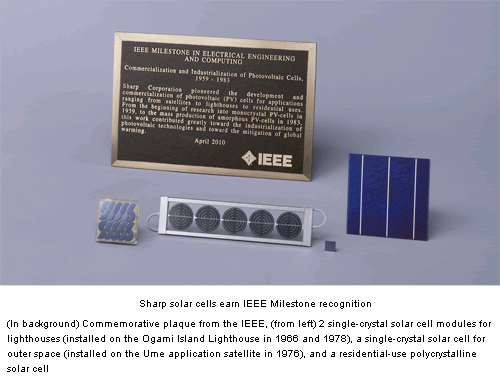
Sharp Corporation’s achievements in the commercialization and industrialization of solar cells from 1959 to 1983 have been recognized as an IEEE Milestone from the IEEE, the world’s largest academic society for electrical, electronics, information, and telecommunications engineering.
The IEEE Milestone honors significant technological innovations in the areas of electrical, electronics, information, and telecommunications engineering that have contributed to the betterment of society and the development of industry. To earn IEEE Milestone recognition, the achievement must have been accomplished at least 25 years ago.
This recognition represents high praise for Sharp’s efforts to bring solar cells into practical use and to contribute to the solar cell industry with products for applications ranging from lighthouses and space satellites to housing. This is Sharp’s second IEEE Milestone, having been awarded one in 2005 for leading the industry in the development of electronic calculators from 1964 to 1973. It is also the 14th IEEE Milestone for a Japanese company.
Sharp’s History of Solar Cell Commercialization and Industrialization 1959 to 1983
| 1959 |
Starts R&D in solar cells |
| 1963 |
Succeeds in the mass production of single-crystal solar cells |
| 1966 |
Installs a 225W solar cell module (the world’s largest, at the time) on the Ogami Island Lighthouse in Nagasaki Prefecture, Japan |
| 1967 |
Starts development of solar cells for outer space |
| 1976 |
Sharp solar cells installed on the Ume application satellite
(Sharp is the only solar cell manufacturer in Japan certified by JAXA [Japan Aerospace Exploration Agency]) |
| 1983 |
Starts development of amorphous solar cells |
Sharp solar cells provide stable and reliable operation over long years of use in a wide range of applications, including residential and industrial use. The use of Sharp solar cells on lighthouses at more than 2,500 locations*3 in harsh seawater and strong winds and on over 160 satellites*3 in the extreme temperatures of outer space gives a proven track record of their reliability.
Sharp will continue its efforts to spread the use of solar cells as it works to become a total solar power solutions company.
| *1 |
The IEEE (“Eye-triple-E”) is the world's largest non-profit association of electrical and electronics engineers, with headquarters in the US. Through its more than 395,000 members worldwide, the IEEE plays a leading role in technical areas ranging from computer engineering, electronics, and telecommunications to electric power, aerospace engineering, and biomedical technology. |
| *2 |
IEEE Milestone
The IEEE established the IEEE Milestone program in 1983 to honor historic achievements—among significant innovations made in the fields of electrical, electronics, information, and telecommunications engineering—that have been recognized as having contributed to the betterment of society and the advancement of industry. Currently there are more than 100 Milestones around the world, including Volta’s Electrical Battery Invention and the Fleming Valve. In Japan, the Directive Short Wave (“Yagi”) Antenna (1995), the Mount Fuji Radar System (2000), the Tokaido Shinkansen (“Bullet Train”) (2000), the Electronic Quartz Wristwatch (2004), and Sharp’s electronic calculator (2005) have been recognized. |
| *3 |
As of April 2010. |
Please note that the commemorative plaque for this IEEE Milestone presented by the IEEE will be on permanent display in the Memorial and Technology Hall of Sharp’s Advanced Development and Planning Center (Tenri City, Nara Prefecture), the Katsuragi Plant (Katsuragi City, Nara Prefecture), and GREEN FRONT SAKAI (Sakai City, Osaka Prefecture). All of these locations are deeply involved in Sharp’s solar cell business.
| The following information is true and accurate at the time of publication. Manufacture, sale, price and specifications of products may be subjected to change. |
|